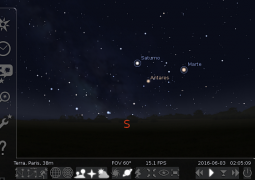

Click the magnifying glass at the right of the search box to lock in on Garradd. Type in "C/2009 Garradd" and you should only see one choice "C/2009 Garradd" below the search box.

Press F3 to open the "Find object" window.
#Stellarium tutorial update#
If you want to see where Garradd will be in the sky, you'll need to update your location and time.Ĥ. Close the Solar System editor and Configuration window.ģ. C/2009 Garradd will then be added to your solar system. Scroll down and check the box next to C/2009 Garradd, then click the "Add objects". C:Users Ian AppDataRoamingStellariumscripts. An "import data" window will open.Ģ.Under the "lists" tab of the "Import data" window, Select the "type" as "comets" select the "source" as "download a list of objects from the internet" under "or select from the list" click on "Select bookmark" and select "MPC's list of observable comets," and then click the button "get orbital elements."Ī list of objects found will load. tab -> Advanced settings (check 'Show hidden files and folders' box) The path to the script folder is usually like. Under the "Solar System tab" of the "Solar System objects" window, click the "Import orbital elements in MPC format" button at the bottom of the tab. A window for "Solar System objects" will open. Stellarium loads the stored landscape (which may set location) other initialisation Stellarium executes startup script Stellarium receives answer from IP location lookup (if configured to do so) and sets location. It shows a realistic star map, just like what you see with the naked eye, binoculars or a telescope.

Stellarium Web is a planetarium running in your web browser. Under "options" at the bottom of the tab, click the "Configure" button. Stellarium Web is a planetarium running in your web browser. Under the "Plugins" tab in the "Configuration" window, select "Solar System Editor". Press F2 to open the "configuration" window.
#Stellarium tutorial upgrade#
It is however important that you upgrade Sellarium to the latest release for it to work.ġ. I'm going to use Comet Garradd as an example as it came up in another thread and is the hot must see comet of the times but it is just as easy to select any other object you like. file and copy it into Stellariums code however this new method makes it fairly simple to do in the main Stellarium application itself adding it directly from the Minor Planet Center. Edit the landscape.ini file using Notepad to match the name and location of your new landscape. Copy one of the landscape folders and rename it. Up until recently to add comets and other extra's to Stellarium you have had to use an ini. Find the Stellarium landscapes folder: C:Program FilesStellariumlandscapes. I thought I would add this method as I haven't seen it posted here before, apologies if it has been.


 0 kommentar(er)
0 kommentar(er)
